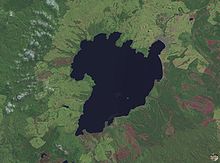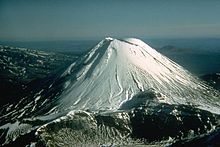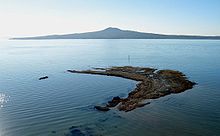Volcanism of New Zealand

The volcanism of New Zealand has been responsible for many of the country's geographical features, especially in the North Island and the country's outlying islands.
While the land's
New Zealand's rocks record examples of almost every kind of volcanism observed on Earth, including some of the world's largest eruptions in geologically recent times.
None of the South Island's volcanoes are active.

Major eruptions

New Zealand has been the site of many large explosive eruptions during the last two million years, including several of
.Two relatively recent eruptions from the
Taupō's most recent major
Hazards
As well as the direct effects of explosions,

For instance, the Tangiwai disaster occurred on 24 December 1953 when the Tangiwai railway bridge across the Whangaehu River collapsed from a lahar in full flood, just before an express train was about to cross it. The train could not stop in time, and 151 people died. This was ultimately caused by Ruapehu's 1945 eruption, which had emptied the crater lake and dammed the outlet with tephra.
An eruption of the Whakaari / White Island stratovolcano occurred on 8 December 2019 while there was a group of 47 visitors on the island. Twenty-two people died, either in the explosion or from injuries sustained, including two whose bodies were never found and were later declared dead. A further 25 people suffered injuries, with the majority needing intensive care for severe burns.[10]
Effects can be widespread even for eruptions of only moderate size. Ash plumes from Ruapehu's 1996 eruption forced the closure of eleven airports, including
Insurance against volcanic damage (along with other natural disasters) is provided by the country's Earthquake Commission.
Cultural references
The

Another legend recounts the exploits of Ngātoro-i-rangi, a tohunga (priest) who arrived from the ancestral Māori homeland, Hawaiki, on the Arawa waka (canoe). Travelling inland and then looking southward from Lake Taupō, he decided to climb the mountains he saw there. He reached and began to climb the first mountain along with his slave Ngāuruhoe, who had been travelling with him, and named the mountain Tongariro (the name literally means 'looking south'), whereupon the two were overcome by a blizzard carried by the cold south wind. Near death, Ngātoro-i-rangi called back to his two sisters, Kuiwai and Haungaroa, who had also come from Hawaiki but remained on Whakaari / White Island, to send him sacred fire, which they had brought from Hawaiki. This they did, sending the fire in the form of two taniwha (powerful spirits) named Te Pupu and Te Haeata by a subterranean passage to the top of Tongariro. The tracks of these two taniwha formed the line of geothermal fire that extends from the Pacific Ocean and beneath the Taupō Volcanic Zone, and is seen in the many volcanoes and hot springs extending from Whakaari to Tokaanu and up to the Tongariro massif. The fire arrived just in time to save Ngātoro-i-rangi from freezing to death, but Ngāuruhoe had already died by the time Ngātoro-i-rangi turned to give him the fire. For this reason the hole through which the fire ascended, the active cone of Tongariro, is now called Ngauruhoe.
Eruptions in the North Island, such as the Kaharoa eruption of Mt Tarawera in 1314, have been used to help determine the approximate date of arrival of the early Polynesian colonists to about 1280. Fossilized footprints of perhaps second- or third-generation Polynesian colonists have been found in volcanic ash on islands in the Hauraki Gulf.
Geology
Please see the main articles above because as already mentioned almost every kind of volcanism observed on Earth is found in New Zealand. For historic intrusive volcanism please see the section on older volcanism below. There is good evidence for continued intrusive volcanism activity in the central North Island.
Volcanic areas
While there are remnants of volcanic activity throughout most of New Zealand, there are several areas where they are more obvious, and somewhere activity continues. Since Taranaki's last activity in 1854, all eruptions have been in the Taupō Volcanic Zone or the Kermadec Arc.[15]

Kermadec Arc
The Kermadec Islands are an active volcanic island arc stretching north-northeast from New Zealand's North Island towards Tonga. While only a few volcanoes in the arc are tall enough to form islands, it includes about 30 sizeable submarine volcanoes with many in the South Kermadec Ridge Seamounts at the New Zealand end of the chain. The largest island, Raoul Island, produced a large eruption around 2200 years ago with a VEI of 6.[16] Its activity has continued intermittently since, with its latest eruption occurring in 2006.[17]
Northland
The Northland region contains two recently active volcanic fields, one centered around Whangarei,[18] and the other is the Kaikohe-Bay of Islands volcanic field.[19] The latest activity in the Kaikohe-Bay of Islands field, around 1300 to 1800 years ago, created four scoria cones at Te Puke (near Paihia).[19]
Earlier, during the
Auckland volcanic field

The
Auckland's volcanoes are believed to be the latest product of an unusual magma source related to local tectonics which is not a classic hot spot, as the earlier volcanic fields are to the south, the opposite expected from movement of the Australian Plate over a stationary mantle plume source.[25]
Waikato and South Auckland

Three volcanic fields erupted between 2.7 and 0.5 million years ago, migrating northwards from Mount Pirongia to the Bombay Hills. The earliest of these fields formed the Alexandra Volcanics[26] which is distinguished by large arc volcano tholeiitic cones but did have associated Okete Volcanics which were traditionally more akaline and oxidised and were in the monogenetic volcanic field pattern seen in the later fields. The distinction between the Alexandra and Okete volcanics is not necessarily clear cut and is still being studied. Alexandra Volcanic Group rocks (mostly basalt) cover about 450 km2 amounting to 55 km3 from at least 40 vents. Mount Pirongia and Mount Karioi are part of the main lineament in the group.[27] The later fields are the smallest Ngatutura Volcanics which comprises about 16 volcanoes south of Port Waikato on the west coast and the South Auckland volcanic field with over 80 volcanoes.[28] The magma body that created the Auckland volcanic field is considered to have been related to these outpourings also. Unlike typical hot spots such as the one underlying Hawaii, it does not seem to have stayed still, but instead is migrating northward at a faster pace than the surrounding Indo-Australian Plate. Its motion has been explained as the tip of a propagating crack produced by the twisting of the North Island's crust.[29][25]
Coromandel Volcanic Zone
The extinct
Mayor Island / Tūhua
Taupō Volcanic Zone

About 350 kilometres long by 50 kilometres wide, the
Taranaki

Volcanism in the Taranaki region has migrated southeastward during the last two million years. Beginning in the Sugar Loaf Islands, near New Plymouth, activity then shifted to Kaitake (580,000 years ago) and Pouakai (230,000 years ago) before creating the large stratovolcano called Mount Taranaki, (former name Mount Egmont), which last erupted in 1854, and its satellite vent, Fanthams Peak.[37] This southeastward migration is the continuation of the 25 million year activity of the Northland-Mohakatino Volcanic Belt that extends mainly under the present Tasman Sea from the west of Northland down to Mount Taranaki.[23]
Chatham Islands
The higher portions of the Chatham Islands are formed from volcanic rock that is up to 81 million years old, although lava flows on the northern shore of Chatham Island date back only about five million years.[38]
Banks Peninsula

Oamaru
Small sub-alkaline basalt to basaltic andesite Surtseyan volcanoes on the submerged continental shelf formed what was historically termed the Waiareka-Deborah volcanic group and now called the Waiareka-Deborah volcanic field in the area around Oamaru around 35 to 30 million years ago.[39][40] A monogenetic volcanic field of more alkaline composition eruptives, with stronger surface features, as they are younger, extends north of Dunedin overlapping the southern Waiareka-Deborah volcanic field, and these volcanoes have now been characterised to be part of the Dunedin volcanic group.[41]
Southern Alps
The Alpine Dyke Swarm of volcanic intusion took place about 25 million years ago and is located near Lake Wānaka in the Southern Alps.[42]
Dunedin
The Dunedin Volcano formed during the Miocene, beginning with basaltic eruptions on the Otago Peninsula, is the largest volcano in the large Dunedin volcanic group.[41] Large central-vent structures formed, and then large domes, with seawater interacting explosively with erupting submarine magma.[43]
Solander Islands
The Solander Islands, a small chain of uninhabited islets close to the western end of the Foveaux Strait, are the emergent portions of a large extinct andesitic volcano that last erupted around 50,000 to 150,000 years ago.[44] Caused by the subduction of the Australian Plate beneath the Pacific Plate, it is the only volcano associated with this subduction zone that protrudes above the sea.[45][46]
Subantarctic islands
The majority of
intraplate volcanoes with ages decreasing towards the northeast, although Antipodes Island may have been active during the last 20,000 years.Older volcanism

Older remnants of volcanism are also found in several places around New Zealand. These were generally formed either when New Zealand still formed part of the
A band of granitic intrusions covering over 10,000 km2, the Median Batholith, stretches from
Basaltic lava flows,
Rhyolitic ignimbrite
The Hikurangi Plateau is an oceanic plateau on the Pacific Plate that attached to the Chatham Ridge after being partially subducted under it, and is now subducting under the North Island. It likely formed in one of the world's largest volcanic outpourings, the greater Ontong Java event.
Ophiolites, volcanic deposits from the ocean floor, have been incorporated into the continental basement of New Zealand in the Dun Mountain Ophiolite Belt, found at both ends of the South Island, and in Northland.
See also
- North Island surface volcanism (for more geology details)
- South Island surface volcanism (for more geology details)
- Geothermal areas in New Zealand
- List of disasters in New Zealand by death toll
- List of earthquakes in New Zealand
- List of volcanoes in Antarctica (for volcanoes in New Zealand's Ross Dependency)
- List of volcanoes in New Zealand
Notes
- ^ Heather Catchpole. Islands of fire Archived 23 February 2010 at the Wayback Machine, Cosmos Magazine.
- .
- .
- .
- ^ .
- ^ "Taupo – Eruptive History". Global Volcanism Program. Smithsonian Institution. Retrieved 16 March 2008.
- S2CID 4309536.
- ^ a b "Okataina: Eruptive History". Global Volcanism Program. Smithsonian Institution.
- ^ Dench, p 114.
- ^ "New Zealand volcano: Divers deployed to find last two missing bodies". 13 December 2019. Archived from the original on 13 December 2019. Retrieved 13 December 2019.
- ^ Mass aircraft grounding possible in NZ too scientists say Archived 22 May 2010 at the Wayback Machine, media release, GNS Science, 19 April 2010.
- doi:10.1130/B31657.1.
- ISSN 2296-6463.
- ISSN 0377-0273.
- ^ Volcanoes of New Zealand to Fiji, Global Volcanism Program, Smithsonian Institution.
- ^ "Smithsonian Global Volcanic Program:Raoul Island".
- ^ "Raoul Island". Global Volcanism Program. Smithsonian Institution.
- ^ "Whangarei Volcanic Field". Global Volcanism Program. Smithsonian Institution.
- ^ a b "Kaikohe-Bay of Islands". Global Volcanism Program. Smithsonian Institution.
- ISBN 1-86962-014-3.
- S2CID 128957126. Archived from the originalon 25 May 2010. Retrieved 20 April 2010.
- ISBN 9780473395964. Retrieved 20 February 2022.
- ^ S2CID 221380777.
- ^ a b Beca Carter Hollings & Ferner (2002). Contingency Plan for the Auckland volcanic field, Auckland Regional Council Technical Publication 165. Accessed 12 May 2008.
- ^ a b Nemeth, Karoly; Kereszturi, Gabor; Agustín-Flores, Javier; Briggs, Roger Michael (2012). "Field Guide Monogenetic volcanism of the South Auckland and Auckland Volcanic Fields". Retrieved 2 November 2022.
- S2CID 129834459.
- ISBN 0-478-08837-X
- hdl:10289/5260.
- ISBN 1-86950-296-5.
- ^ Hayward, B. (2008). Protecting NZ's Heritage Natural Arches, Geological Society of New Zealand Newsletter 145 (March), 23.
- .
- ^ .
- .
- ^ "Mayor Island". Global Volcanism Program. Smithsonian Institution.
- ^ Karl D. Spinks, J.W. Cole, & G.S. Leonard (2004). Caldera Volcanism in the Taupō Volcanic Zone. In: Manville, V.R. (ed.) Geological Society of New Zealand/New Zealand Geophysical Society/26th New Zealand Geothermal Workshop, 6–9 December 2004 , Taupo: field trip guides. Geological Society of New Zealand miscellaneous publication 117B.
- ^ Volcanology highlights, Volcanoes of New Zealand to Fiji, Global Volcanism Program, Smithsonian Institution.
- .
- ^ a b K. S. Panter, J. Blusztajn, S. R. Hart, P. R. Kyle, R. Esser, W. C. McIntosh (2006). The Origin of HIMU in the SW Pacific: Evidence from Intraplate Volcanism in Southern New Zealand and Subantarctic Islands
- ^ Simone Hicks, PhD proposal: Ecological and sedimentological evolution of the volcanically active Oligocene continental shelf, east Otago, New Zealand, Geology Department, University of Otago. Retrieved 19 April 2010.
- S2CID 129657592.
- ^ S2CID 212937447.
- S2CID 210266079.
- ^ ""Eruptions and deposition of volcaniclastic rocks in the Dunedin Volcanic Complex, Otago Peninsula, New Zealand", Ulrike Martin". Archived from the original on 8 June 2011. Retrieved 18 April 2010.
- doi:10.1086/671397.
- ^ Keith Lewis, Scott D. Nodder and Lionel Carter. 'Sea floor geology – Solander Island', Te Ara – the Encyclopedia of New Zealand. Updated 2 March 2009. Accessed 18 April 2010.
- ISSN 0377-0273.
- .
- .
- .
- S2CID 128898123.
References
- Dench, Alison; Essential Dates: A Timeline of New Zealand History, Auckland: Random House, 2005 ISBN 1-86941-689-9

